-John Hefner – January 2018
Having grown roses for more than forty years, I have had many experiences and continue to learn more about our wonderful rose growing hobby. For me, without a doubt, the most devastating and frustrating experience concerns that of rose midge.
Reports indicate that midge has been a known pest for years dating back to the early 1930’s or before and it is now present in most states. Midge is difficult to control due to the short life cycle as it reproduces faster than most rose gardeners can control pesticide applications. In my garden, it appeared the emergence was almost perfectly timed to the spring new plant growth and formation of the flower bud.
MY EXPERIENCE…
During the 2010 growing season, my rose garden was nearly void of blooms due to a major midge infestation. No matter how hard I tried, I simply could not get the problem under control. A guest commented that the experience of visiting my garden was like going to a funeral. I attempted several control methods, ranging from using various chemical applications as well as pruning off newly developing buds. I found that midge was so widespread that it was almost impossible to control. By close examination, I found that many damaged buds had as many as 12-15 developing larvae. Multiply this by 200-300 plants, one can understand my frustration resulting in almost no blooms.
UNDERSTANDING THIS PEST…
To control this pest, we must understand and break the cycle of reproduction. The adult midge is a very small mosquito-like insect approximately one millimeter in length. During this stage, identification is difficult as very few rosarians have ever seen one. The female deposits her eggs in or under the new leaf tips of the developing bud. It is at this stage that the damage takes place. The eggs hatch into larvae that appear as very small white worms which proceed to chew the stem of the developing bud causing it to turn black and fall off. In some cases, the results are a badly tipped bud. After feeding, the larvae drops from the stem and burrows into the soil at the base of the plant. Development continues and the adult emerges about seven days later.
To observe the midge larvae during an infestation, examine a new shoot when the bud is becoming visible. If present, the larvae will appear as small white maggots. If you search the already blackened tip, the larvae have departed and are developing underground.
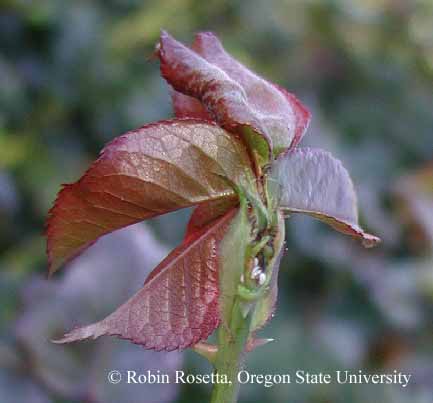
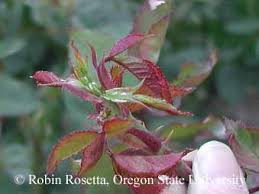
Those buds which are fully destroyed give the appearance of a developing blind shoot. No further growth will take place at the growth tip and the cane must be pruned to allow new growth to take place. Once damaged, the cane will not produce a flower for another bloom cycle. Repeated many times over it can also result in a rose garden nearly void of blooms.
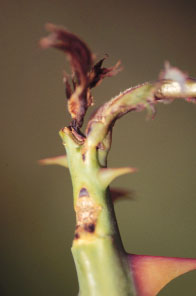
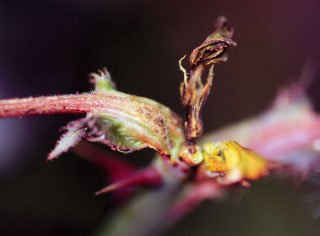
Once your garden has experienced a problem with midge, early proactive control should begin at pruning time when winter protection is removed as it is possible that midge can overwinter in your rose garden mulch. If damage has occurred in the past, assume that midge is present and the initial control should take place in early spring before bud development occurs. Control of midge requires abandonment of the rules of insect application – that of not spraying until damage is evident.
EFFECTIVE CONTROL…
Effective chemicals which I have had success for midge control include Imidacloprid and Cyonara 9.7. Imidaclorid (Merit) and cyfluthrin are chemicals which are sold as Bayer Advanced “Complete Insect Killer” may be purchased as a liquid or it is an ingredient in a granular form in some lawn insecticides. Cyonara 9.7 is a liquid insecticide and may be used as a foliar spray or as a soil application.
Having experienced rose midge devastation and a garden void of blooms, the following is what I have learned.
- Once a garden has had a midge infestation, it will likely return unless control measures are taken.
- Close observations are necessary, examine developing buds for damage. If damage is determined, treat immediately. Destroy the damaged growth.
- Always remember that preventative insecticides must be applied prior to damage. Control measures should take place after winter protection is removed.
- Since the midge develops underground, preventative measures must include soil treatment. If granular products are used, they must be watered in to be effective.
- My experience is that once midge is present, it is necessary to break the life cycle with treatment every three days for two weeks.
- For reasons unknown, midge prefers the healthiest cane to deposit developing eggs.
- For me, the most effective preventative insecticide has been Cyonara 9.7. It may be purchased online and is relative inexpensive and can be used as a soil drench and a foliar spray.
MORE TIPS…
- As of this time, research indicates there is no known good biological control for rose midge.
- Non chemical control would be removal of affected new growth and destroying the debris.
- Another method indicates the removal of two inches of current mulch in the fall and replace it with new mulch.
- Never compost affected clippings due to the possibility of the developing larvae.
WE CAN HELP…
Here’s hoping you never encounter this rose pest, but be insured that our society’s Consulting Rosarians and members who have experienced a midge attack are always willing to discuss your rose growing concerns and answer your questions! Contact us here.
We will help you get back to beautiful blooms!
The Indianapolis Rose Society visited the Hefner Garden last summer and we were immersed in wonderful blooms, friends and food.
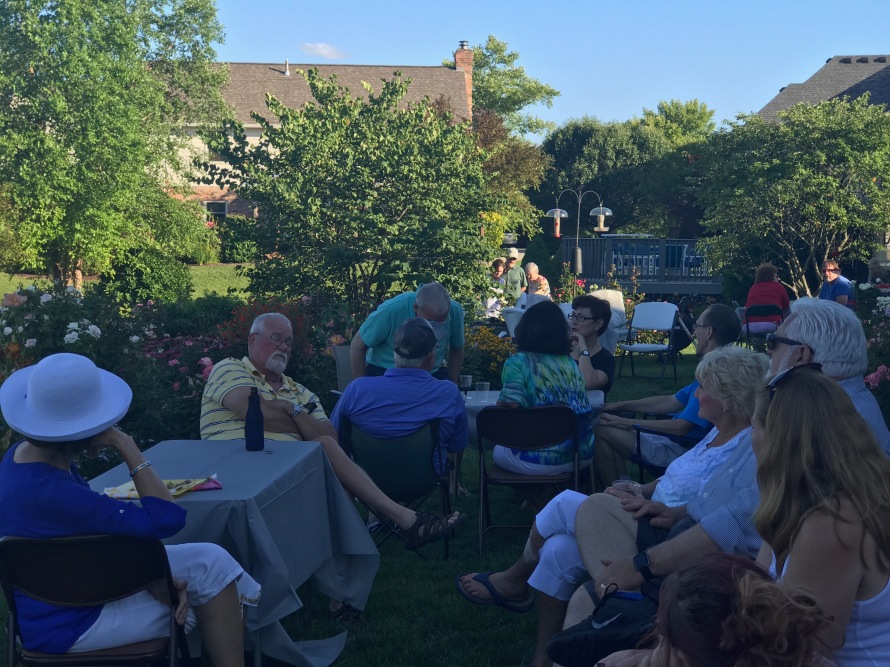
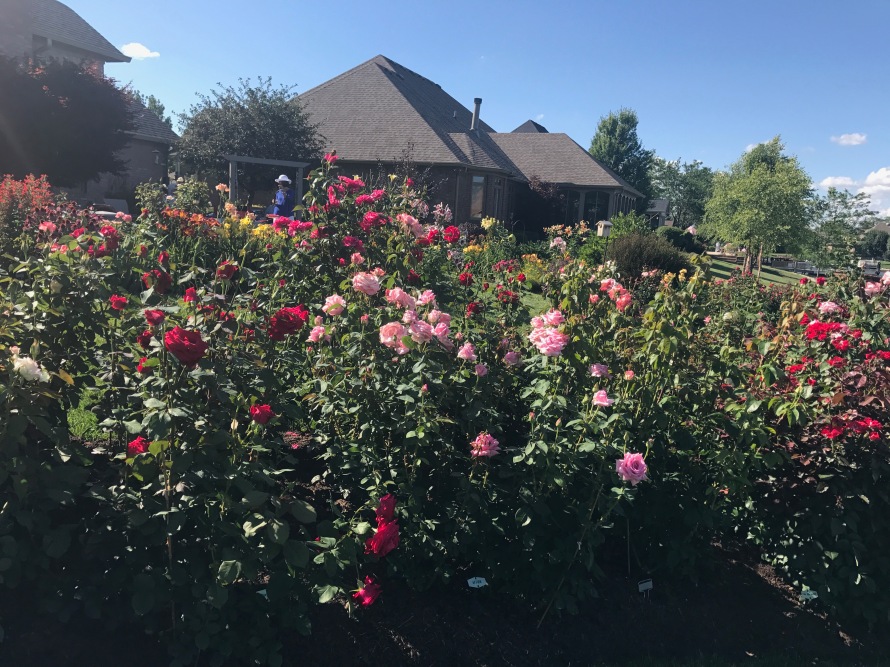
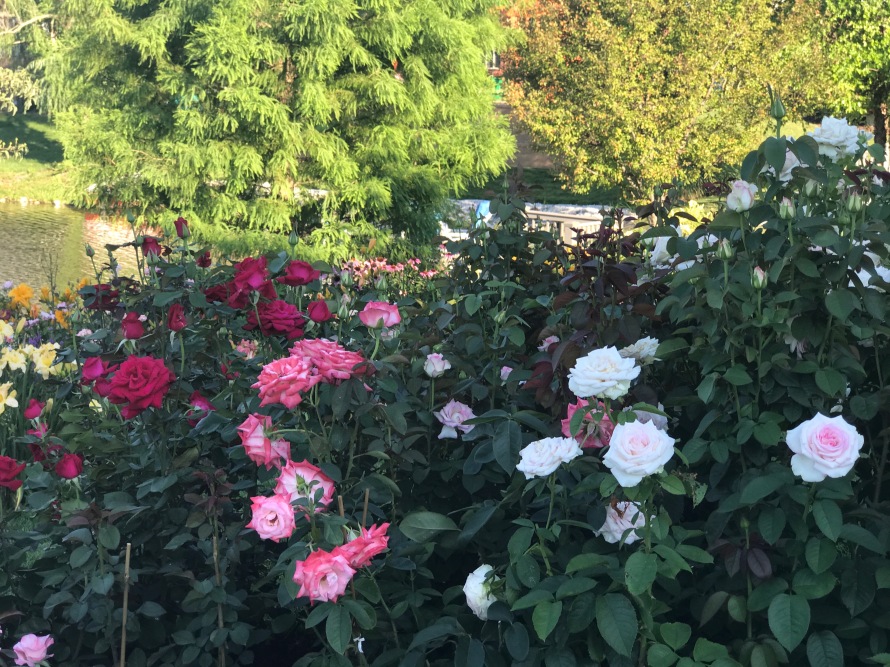

Having grown roses for more than forty years, I have had many experiences and continue to learn more about our wonderful rose growing hobby. For me, without a doubt, the most devastating and frustrating experience concerns that of rose midge.
Reports indicate that midge has been a known pest for years dating back to the early 1930’s or before and it is now present in most states. Midge is difficult to control due to the short life cycle as it reproduces faster than most rose gardeners can control pesticide applications. In my garden, it appeared the emergence was almost perfectly timed to the spring new plant growth and formation of the flower bud.
MY EXPERIENCE…
During the 2010 growing season, my rose garden was nearly void of blooms due to a major midge infestation. No matter how hard I tried, I simply could not get the problem under control. A guest commented that the experience of visiting my garden was like going to a funeral. I attempted several control methods, ranging from using various chemical applications as well as pruning off newly developing buds. I found that midge was so widespread that it was almost impossible to control. By close examination, I found that many damaged buds had as many as 12-15 developing larvae. Multiply this by 200-300 plants, one can understand my frustration resulting in almost no blooms.
UNDERSTANDING THIS PEST…
To control this pest, we must understand and break the cycle of reproduction. The adult midge is a very small mosquito-like insect approximately one millimeter in length. During this stage, identification is difficult as very few rosarians have ever seen one. The female deposits her eggs in or under the new leaf tips of the developing bud. It is at this stage that the damage takes place. The eggs hatch into larvae that appear as very small white worms which proceed to chew the stem of the developing bud causing it to turn black and fall off. In some cases, the results are a badly tipped bud. After feeding, the larvae drops from the stem and burrows into the soil at the base of the plant. Development continues and the adult emerges about seven days later.
To observe the midge larvae during an infestation, examine a new shoot when the bud is becoming visible. If present, the larvae will appear as small white maggots. If you search the already blackened tip, the larvae have departed and are developing underground.


Those buds which are fully destroyed give the appearance of a developing blind shoot. No further growth will take place at the growth tip and the cane must be pruned to allow new growth to take place. Once damaged, the cane will not produce a flower for another bloom cycle. Repeated many times over it can also result in a rose garden nearly void of blooms.


Once your garden has experienced a problem with midge, early proactive control should begin at pruning time when winter protection is removed as it is possible that midge can overwinter in your rose garden mulch. If damage has occurred in the past, assume that midge is present and the initial control should take place in early spring before bud development occurs. Control of midge requires abandonment of the rules of insect application – that of not spraying until damage is evident.
EFFECTIVE CONTROL…
Effective chemicals which I have had success for midge control include Imidacloprid and Cyonara 9.7. Imidaclorid (Merit) and cyfluthrin are chemicals which are sold as Bayer Advanced “Complete Insect Killer” may be purchased as a liquid or it is an ingredient in a granular form in some lawn insecticides. Cyonara 9.7 is a liquid insecticide and may be used as a foliar spray or as a soil application.
Having experienced rose midge devastation and a garden void of blooms, the following is what I have learned.
- Once a garden has had a midge infestation, it will likely return unless control measures are taken.
- Close observations are necessary, examine developing buds for damage. If damage is determined, treat immediately. Destroy the damaged growth.
- Always remember that preventative insecticides must be applied prior to damage. Control measures should take place after winter protection is removed.
- Since the midge develops underground, preventative measures must include soil treatment. If granular products are used, they must be watered in to be effective.
- My experience is that once midge is present, it is necessary to break the life cycle with treatment every three days for two weeks.
- For reasons unknown, midge prefers the healthiest cane to deposit developing eggs.
- For me, the most effective preventative insecticide has been Cyonara 9.7. It may be purchased online and is relative inexpensive and can be used as a soil drench and a foliar spray.
MORE TIPS…
- As of this time, research indicates there is no known good biological control for rose midge.
- Non chemical control would be removal of affected new growth and destroying the debris.
- Another method indicates the removal of two inches of current mulch in the fall and replace it with new mulch.
- Never compost affected clippings due to the possibility of the developing larvae.
WE CAN HELP…
Here’s hoping you never encounter this rose pest, but be insured that our society’s Consulting Rosarians and members who have experienced a midge attack are always willing to discuss your rose growing concerns and answer your questions! Contact us here.
We will help you get back to beautiful blooms!
The Indianapolis Rose Society visited the Hefner Garden last summer and we were immersed in wonderful blooms, friends and food.





